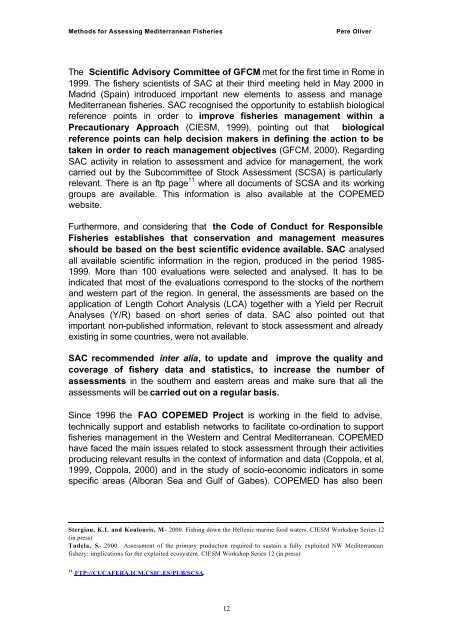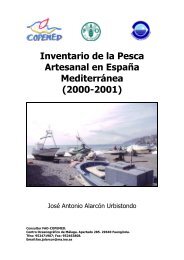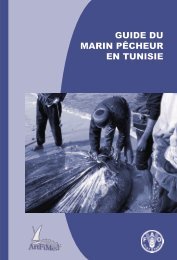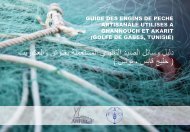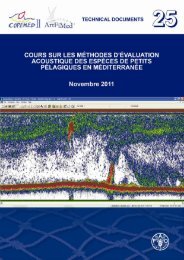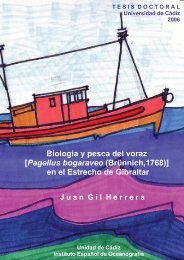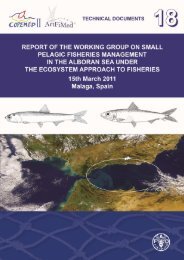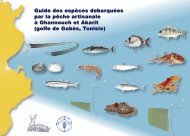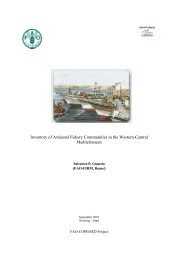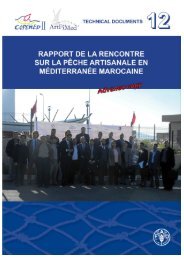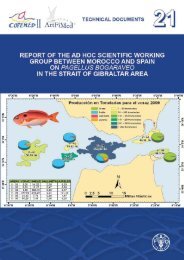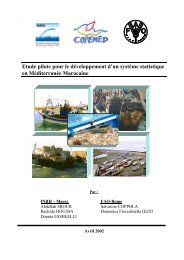Methods for Assessing Mediterranean Fisheries - Fao - Copemed
Methods for Assessing Mediterranean Fisheries - Fao - Copemed
Methods for Assessing Mediterranean Fisheries - Fao - Copemed
Create successful ePaper yourself
Turn your PDF publications into a flip-book with our unique Google optimized e-Paper software.
<strong>Methods</strong> <strong>for</strong> <strong>Assessing</strong> <strong>Mediterranean</strong> <strong>Fisheries</strong><br />
Pere Oliver<br />
The Scientific Advisory Committee of GFCM met <strong>for</strong> the first time in Rome in<br />
1999. The fishery scientists of SAC at their third meeting held in May 2000 in<br />
Madrid (Spain) introduced important new elements to assess and manage<br />
<strong>Mediterranean</strong> fisheries. SAC recognised the opportunity to establish biological<br />
reference points in order to improve fisheries management within a<br />
Precautionary Approach (CIESM, 1999), pointing out that biological<br />
reference points can help decision makers in defining the action to be<br />
taken in order to reach management objectives (GFCM, 2000). Regarding<br />
SAC activity in relation to assessment and advice <strong>for</strong> management, the work<br />
carried out by the Subcommittee of Stock Assessment (SCSA) is particularly<br />
relevant. There is an ftp page 11 where all documents of SCSA and its working<br />
groups are available. This in<strong>for</strong>mation is also available at the COPEMED<br />
website.<br />
Furthermore, and considering that the Code of Conduct <strong>for</strong> Responsible<br />
<strong>Fisheries</strong> establishes that conservation and management measures<br />
should be based on the best scientific evidence available. SAC analysed<br />
all available scientific in<strong>for</strong>mation in the region, produced in the period 1985-<br />
1999. More than 100 evaluations were selected and analysed. It has to be<br />
indicated that most of the evaluations correspond to the stocks of the northern<br />
and western part of the region. In general, the assessments are based on the<br />
application of Length Cohort Analysis (LCA) together with a Yield per Recruit<br />
Analyses (Y/R) based on short series of data. SAC also pointed out that<br />
important non-published in<strong>for</strong>mation, relevant to stock assessment and already<br />
existing in some countries, were not available.<br />
SAC recommended inter alia, to update and improve the quality and<br />
coverage of fishery data and statistics, to increase the number of<br />
assessments in the southern and eastern areas and make sure that all the<br />
assessments will be carried out on a regular basis.<br />
Since 1996 the FAO COPEMED Project is working in the field to advise,<br />
technically support and establish networks to facilitate co-ordination to support<br />
fisheries management in the Western and Central <strong>Mediterranean</strong>. COPEMED<br />
have faced the main issues related to stock assessment through their activities<br />
producing relevant results in the context of in<strong>for</strong>mation and data (Coppola, et al,<br />
1999, Coppola, 2000) and in the study of socio-economic indicators in some<br />
specific areas (Alboran Sea and Gulf of Gabes). COPEMED has also been<br />
Stergiou, K.I. and Koulouris, M.- 2000. Fishing down the Hellenic marine food waters. CIESM Workshop Series 12<br />
(in press)<br />
Tudela, S.- 2000. Assessment of the primary production required to sustain a fully exploited NW <strong>Mediterranean</strong><br />
fishery: implications <strong>for</strong> the exploited ecosystem. CIESM Workshop Series 12 (in press)<br />
11 FTP://CUCAFERA.ICM.CSIC.ES/PUB/SCSA.<br />
12


